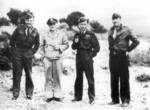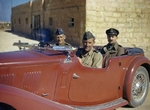Arthur Coningham
| Surname | Coningham |
| Given Name | Arthur |
| Born | 19 Jan 1895 |
| Died | 30 Jan 1948 |
| Country | New Zealand, United Kingdom |
| Category | Military-Air |
| Gender | Male |
Contributor: C. Peter Chen
ww2dbaseArthur Coningham was born in Brisbane, Queensland, Australia to con artist Arthur Coningham who took his family in fleeing from Australia to New Zealand while the future air force senior officer was still very young. The Coningham parents divorsed due to the older Coningham's infidelity when the younger Coningham was 17 years of age. He was granted a scholarship to attend Wellington College. In 1914, he volunteered for the military and served in Egypt, Somaliland, and the Gallipoli peninsula with the New Zealand Expeditionary Force and then served in Britain and France with the British Royal Flying Corps, finishing the war at the rank of major and as the commanding officer of No. 92 Squadron. It was during WW1 that he acquired the nickname Maori, which corrupted into Mary, the latter of which became the name for which he was referred to by his closest comrades. In the early 1920s, he served as a technical and flight instructor, and then was assigned to No. 55 Squadron based in Mosul, Iraq. In 1923, he was given command of No. 55 Squadron. Between 1924 and 1926, he was attached to the headquarters of Egyptian Group and then the headquarters of Royal Air Force (RAF) Middle East. After further service at the Royal Air Force College Cranwell in Lincolnshire and then the Central Flying School at Wiltshire, both in England, United Kingdom, he became a wing commander. In 1932, he was assigned to Sudan as the senior RAF officer. In 1935, he served as a staff officer with the RAF Coastal Area. In the following year he became the Senior Air Staff Officer at the headquarters of No. 17 Group. Between 1937 and 1939, he was the commanding officer of RAF Calshot in Hampshire, England. When the European War of WW2 began in 1939, he was the commanding officer of No. 4 Group of RAF Bomber Command. He would remain in this role through 1941 in the early aerial bombing campaigns against German positions in Germany, France, and the Low Countries. In 1941, he was transferred to the Middle East as the commanding officer of the Western Desert Air Force; in this role he was credited with supporting the eventual Allied victory in North Africa, particularly with stopping the German advance at El Alamein, Egypt in 1942 where he operated with great cooperation with Bernard Montgomery's ground troops (although his relationship would deteriorate greatly later in the war). He would remain in charge of tactical air operations through the invasion of Sicily, Italy and mainland Italy until he was transferred from 1st Allied Tactical Air Force to 2nd Allied Tactical Air Force for the invasion of France. He was relieved by Sholto Douglas as the commanding officer of 2nd Tactical Air Force shortly after the end of the European War, in Jul 1945. Between late 1945 and Aug 1947, he served as the chief of Flying Training Command. In 1947, he was made commodore of the Royal Air Force Yacht Club. In Jan 1948, while traveling aboard a Avro 688 Tudor Mark IV passenger aircraft operated by British South American Airways from Santa Maria, Azores to Bermuda, he disappeared along with all others aboard in the Bermuda Triangle in poor weather. A total of 26 US Air Force aircraft were assigned to search for the missing passenger aircraft, but the search was abandoned after five days.
ww2dbaseSource: Wikipedia
Last Major Revision: Apr 2013
Arthur Coningham Interactive Map
Photographs
 |  |  |  |
Arthur Coningham Timeline
| 19 Jan 1895 | Arthur Coningham was born in Brisbane, Queensland, Australia. |
| 17 Sep 1917 | Arthur Coningham was awarded the Military Cross medal. |
| 26 Sep 1917 | Arthur Coningham was awarded the Distinguished Service Order medal of Britain. |
| 11 Dec 1917 | Arthur Coningham was Mentioned in Despatches. |
| 6 Jun 1919 | Arthur Coningham was awarded the Distinguished Flying Cross medal. |
| 11 Jun 1924 | Arthur Coningham was Mentioned in Despatches. |
| 1 Jan 1926 | Arthur Coningham was awarded the Air Force Cross medal. |
| 1 Jan 1941 | Arthur Coningham was Mentioned in Despatches. |
| 24 Sep 1941 | Arthur Coningham was made Knight Grand Cross of the Order of the Bath. |
| 11 Jun 1942 | Arthur Coningham was Mentioned in Despatches. |
| 27 Nov 1942 | Arthur Coningham was made Knight Commander of the Order of the Bath. |
| 27 Aug 1943 | Arthur Coningham was made Chief Commander of the Legion of Merit of the United States. |
| 3 Aug 1945 | Arthur Coningham was awarded the Distinguished Service Medal of the United States. |
| 23 Nov 1945 | Arthur Coningham was made Grand Officer of the Order of Leopold and was awarded Croix de Guerre of Belgium with Palms. |
| 1 Jan 1946 | Arthur Coningham was made Knight Commander of the Order of the British Empire. |
| 6 Sep 1946 | Arthur Coningham was awarded Grand Cross of the Order of the Phoenix of Greece. |
| 1 Aug 1947 | Arthur Coningham retired from the Royal Air Force. |
| 18 Nov 1947 | Arthur Coningham was awarded Knight Grand Cross of the Order of Orange Nassau of the Netherlands. |
| 28 Jan 1948 | Arthur Coningham departed Lisbon, Portugal. |
| 29 Jan 1948 | Arthur Coningham departed Santa Maria, Azores. |
| 30 Jan 1948 | The Avro 688 Tudor Mark IV aircarft which Arthur Coningham traveled aboard disappeared in the Bermuda Triangle some time between 0304 hours and 0350 hours. |
Please consider supporting us on Patreon. Even $1 per month will go a long way! Thank you. Please help us spread the word: Stay updated with WW2DB: |
Visitor Submitted Comments
All visitor submitted comments are opinions of those making the submissions and do not reflect views of WW2DB.
» First Battle of El Alamein
» Second Battle of El Alamein
» Normandy Campaign, Phase 1
» Normandy Campaign, Phase 2
» Crossing the Rhine
- » 1,167 biographies
- » 337 events
- » 44,606 timeline entries
- » 1,243 ships
- » 350 aircraft models
- » 207 vehicle models
- » 376 weapon models
- » 123 historical documents
- » 261 facilities
- » 470 book reviews
- » 28,497 photos
- » 365 maps
James Forrestal, Secretary of the Navy, 23 Feb 1945
Please consider supporting us on Patreon. Even $1 a month will go a long way. Thank you!
Or, please support us by purchasing some WW2DB merchandise at TeeSpring, Thank you!
13 Apr 2013 12:32:08 AM
Mary Coningham's size when he met him at the D.A.F.'s Headquarters in North Aftica - over six foot tall with broad shoulders and strong, well tanned face, neck and arms. His eyes sparkled and he was quick to laugh. It was important, he told Cecil, to make sure the men never became too static. If he discovered someone had built themselves concrete floor, he moved them on a mile. Every Squadron, whether fighter or bomber, had to be ready to move their aircraft, equipment tents - the lot - at an hours notice. Because of the heat and emptiness of the desert, it was hard to keep the men fresh and alert, but he insisted each man work every hour of daylight, to make them 'pleased to go to bed'. Relaxation was important too, however, 'I always send batches of thirty people at a time down to the beaches,' he told Cecil 'for a holiday to keep them efficient and give them a break of thirty-six hours.' Logistics were, of course, his biggest headache. Provisions, he told Cecil, would win the desert war. 'To fight here is like trying to fill a bath without a plug,' he continued,'where everything gets washed down the pipe. There are two hundred thousand gallons of petrol used here every week, eighty thousand vehicles of which the life of each is only about six months.' Aircraft had to be overhauled constantly. Mary smiled. 'It is, as the captured German General von Ravenstein said, the tactician's paradise and the quartermaster's nightmare.
James Holland, Together We Stand, Harper/ Collins, 2006 pp23-24)